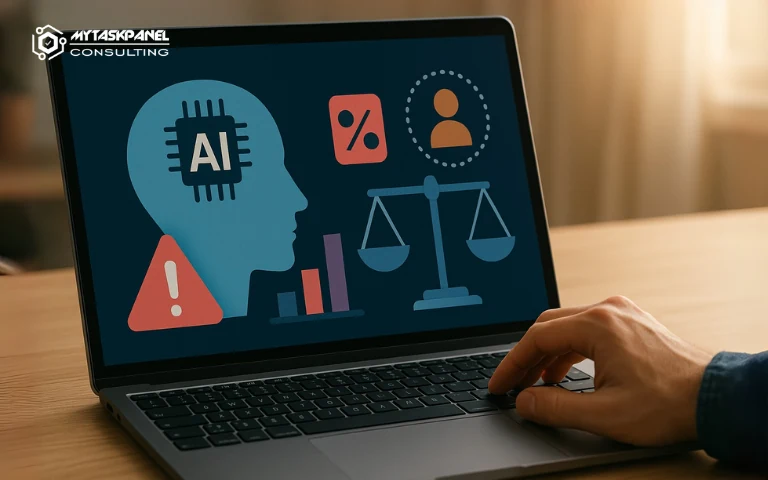Artificial intelligence (AI) is increasingly present in our lives: from product recommendations to hiring decisions or credit approvals. However, a growing concern is algorithmic bias in AI, a phenomenon that can lead to unfair, discriminatory, or erroneous outcomes.
In this article, we explain in depth what it is, how it occurs, real examples, and key strategies to mitigate this problem.
What is algorithmic bias in AI?
Algorithmic bias in AI refers to the tendency of an artificial intelligence system to produce partial, discriminatory, or unbalanced results due to the way it was designed, trained, or implemented.
Although many people believe algorithms are inherently objective, these systems actually learn from data provided by humans. If the training data is biased or reflects existing inequalities, the algorithms will perpetuate (and even amplify) those biases.
Bias can manifest in different ways:
- Bias in the data: when historical data contains prejudices (e.g., fewer women hired in tech sectors).
- Bias in model design: when design decisions prioritize certain metrics or features without considering fairness or diversity.
- Bias in implementation: when the system is deployed in unforeseen contexts or without adequate human oversight.
Real examples of algorithmic bias in AI
1. Amazon and its recruitment system
In 2018, Amazon had to discard an AI system designed to filter resumes because it systematically penalized female candidates. The model had been trained on previous hiring data (mainly men), so it learned to associate success with male gender.
2. Facial recognition and racial discrimination
Studies have shown that some facial recognition algorithms have higher error rates for people with darker skin compared to white people. This is due to unbalanced training datasets containing fewer images of non-white individuals.
3. Predictive justice systems in the U.S.
Some tools used to predict criminal recidivism have shown racial biases, rating African Americans as more likely to reoffend despite no real correlation existing in the data.
These examples illustrate how algorithmic bias in AI can have serious consequences on rights, opportunities, and social justice.
How does algorithmic bias occur?
1. Data collection and selection
Data reflects existing realities, with all their inequalities and stereotypes. If a dataset underrepresents certain groups (e.g., ethnic minorities), the model will be less accurate for those groups.
2. Model design
Optimization objectives may focus solely on accuracy or efficiency, without incorporating fairness metrics. Additionally, technical decisions (such as how to encode sensitive variables) can introduce subtle biases.
3. Training and validation
If the model’s performance is not evaluated across different population segments, differences that negatively affect some groups may go unnoticed.
4. Implementation and use
A model that works well in one context may be unsuitable in another. For example, a system trained on U.S. data may not be reliable in Latin America if it does not account for cultural and demographic differences.
Consequences of algorithmic bias in AI
Bias in AI systems is not just a technical issue, but also an ethical, legal, and social one. Its most relevant consequences include:
- Indirect discrimination: algorithms can replicate historical prejudices under the guise of objectivity.
- Loss of trust: users may lose faith in AI technologies if they perceive decisions as unfair or inexplicable.
- Reputational and legal damage: companies implementing AI without bias control may face lawsuits, regulatory sanctions, and damage to their image.
How to mitigate algorithmic bias in AI
1. Diverse and balanced data collection
Ensure training datasets include sufficient representation of all social groups. This involves actively reviewing and curating data, even generating synthetic data if necessary.
2. Algorithmic audits
Conduct periodic audits of model performance, both during development and after deployment, to detect biases. These audits can be internal or external (by specialized third parties).
3. Transparency and explainability
Develop interpretable models that allow understanding of how decisions are made. This facilitates bias detection and increases trust in AI systems.
4. Fairness metrics
Incorporate metrics such as demographic parity, equal opportunity, or predictive fairness in model evaluation. This way, you optimize not only accuracy but also justice.
5. Interdisciplinary participation
Involve experts in ethics, sociology, human rights, and affected communities in system design to identify risks not evident from a purely technical perspective.
6. Governance and regulations
Implement internal governance policies defining ethical standards for AI use. It is also key to comply with emerging regulations, such as the European Union’s AI Act, which promotes fairness and accountability.
The role of IT companies
Technology consultancies like MyTaskPanel Consulting play a key role in mitigating algorithmic bias in AI. By designing, developing, and auditing intelligent systems for clients, we are responsible for:
- Promoting ethical development practices.
- Training teams on algorithmic fairness.
- Ensuring traceability and human oversight in critical systems.
- Prioritizing fair and transparent solutions.
By incorporating good practices from the early project phases, it is possible to create more inclusive, reliable, and ethical artificial intelligence.
Algorithmic bias in AI is one of the great challenges of the digital age. Far from being an isolated failure, it is a direct consequence of how we build and use intelligent systems. Detecting, understanding, and mitigating it is a collective task involving developers, companies, governments, and civil society.
At MyTaskPanel Consulting, we believe in the transformative power of technology when used responsibly. We advocate for ethical AI focused on people and designed with fairness criteria from the ground up.
Is your company ready to face this challenge? Contact us to discover how we can help you develop bias-free, secure AI solutions aligned with your values.

